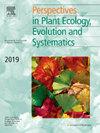Fairy circle research: Status, controversies and the way forward
IF 2.9
3区 环境科学与生态学
Q1 ECOLOGY
Perspectives in Plant Ecology Evolution and Systematics
Pub Date : 2025-02-17
DOI:10.1016/j.ppees.2025.125851
引用次数: 0
Abstract
- 1)Fairy circles are regularly spaced barren circular patches in arid landscapes, typically encircled by a ring of taller grasses. They occur in South-western Africa and have also been suggested to occur in Australia, North Africa, Middle East and Madagascar. The enigmatic origins of fairy circles in arid landscapes have intrigued ecologists and sparked heated debate about the two main competing hypotheses: the termite origin (TO) and vegetation self-organization (VSO) hypotheses. In this review we attempt to untangle the claims and counter-claims regarding the two hypotheses in a dispassionate manner.
- 2)The TO hypothesis posits that fairy circles form due to activities of Psammotermes allocerus termites, which through their foraging and nest-building behaviour create barren patches in arid grasslands, leading to the characteristic circular formations whose spacing results from competitive interactions between P. allocerus colonies.
- 3)The VSO hypothesis posits that fairy circles in arid landscapes are the product of self-organizing behaviour of plants competing for limited water resources. Competition between neighbouring plants leads to the formation of barren circular patches with grassy peripheries. Water and nutrient mobility in coarse aeolian sands play a critical role in the shape and spacing between fairy circles.
- 4)Problems with the TO hypothesis include the inconsistent central location of termite colonies within fairy circles, the difficulty of aligning the long-term persistence and stability of fairy circles with termite population dynamics, and the lack of evidence for aggressive termite interactions at the scale of the fairy circle pattern.
- 5)The main challenge for the VSO hypothesis is a lack of direct empirical evidence, especially concerning complex underground water and nutrient fluxes. The precise mechanisms behind VSO remain unclear, making it difficult to fully validate this hypothesis as the sole explanation for fairy circles.
- 6)Synthesis: This analysis underscores the VSO hypothesis as a coherent explanation for fairy circle formation. Progress will require manipulative experiments with environmental factors (e.g., termite presence, soil nutrients, water availability) that test the hypotheses directly. Long-term monitoring to observe fairy circle development and changes under varying conditions is also required.
仙女圈研究:现状、争议与前进方向
仙女圈是干旱地区有规律分布的贫瘠圆形斑块,通常被一圈较高的草所环绕。它们出现在非洲西南部,也有人认为出现在澳大利亚、北非、中东和马达加斯加。干旱景观中仙女圈的神秘起源引起了生态学家的兴趣,并引发了两种主要假说的激烈争论:白蚁起源假说和植被自组织假说。在这篇综述中,我们试图以一种冷静的方式澄清关于这两个假设的主张和反主张。2)to假设认为仙女圈的形成是由于白蚁的活动,白蚁通过觅食和筑巢行为在干旱的草原上创造了贫瘠的斑块。3) VSO假说认为,干旱景观中的仙女圈是植物争夺有限水资源的自组织行为的产物。邻近植物之间的竞争导致形成了贫瘠的圆形斑块,周围长满了草。4) TO假说存在的问题包括:仙女圈内白蚁群落的中心位置不一致;仙女圈的长期持久性和稳定性难以与白蚁种群动态相一致;5) VSO假说面临的主要挑战是缺乏直接的经验证据,特别是在复杂的地下水和养分通量方面。VSO背后的确切机制尚不清楚,因此很难完全验证这一假说作为仙女圈形成的唯一解释。6)综合:该分析强调了VSO假说作为仙女圈形成的连贯解释。要取得进展,就需要对环境因素(如白蚁存在、土壤养分、水分供应)进行可操作的实验,直接检验这些假设。还需要长期监测,观察仙女圈在不同条件下的发展和变化。
本文章由计算机程序翻译,如有差异,请以英文原文为准。
求助全文
约1分钟内获得全文
求助全文
来源期刊
CiteScore
6.50
自引率
0.00%
发文量
28
审稿时长
67 days
期刊介绍:
Perspectives in Plant Ecology, Evolution and Systematics (PPEES) publishes outstanding and thought-provoking articles of general interest to an international readership in the fields of plant ecology, evolution and systematics. Of particular interest are longer, in-depth articles that provide a broad understanding of key topics in the field. There are six issues per year.
The following types of article will be considered:
Full length reviews
Essay reviews
Longer research articles
Meta-analyses
Foundational methodological or empirical papers from large consortia or long-term ecological research sites (LTER).

 求助内容:
求助内容: 应助结果提醒方式:
应助结果提醒方式:


